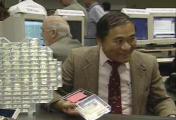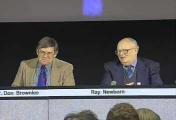MEDIA RELATIONS OFFICE
JET PROPULSION LABORATORY
CALIFORNIA INSTITUTE OF TECHNOLOGY
NATIONAL AERONAUTICS AND SPACE ADMINISTRATION
PASADENA, CALIF. 91109. TELEPHONE (818) 354-5011
http://www.jpl.nasa.gov
DC Agle (818) 393-9011
Jet Propulsion Laboratory, Pasadena, Calif.
Donald Savage (202) 358-1547
NASA Headquarters, Washington, D.C.
News Release: 2004-001 January 2, 2004
NASA Spacecraft Makes Great Catch...Heads for Touchdown
 Comet Wild 2 is shown in this
image taken by the Stardust
navigation camera during the
spacecraft's closest approach
to the comet on January 2. The
image was taken within a
distance of 500 kilometers
(about 311 miles) of the
comet's nucleus with a
10-millisecond exposure.
Comet Wild 2 is shown in this
image taken by the Stardust
navigation camera during the
spacecraft's closest approach
to the comet on January 2. The
image was taken within a
distance of 500 kilometers
(about 311 miles) of the
comet's nucleus with a
10-millisecond exposure.
1.4 MB TIF
|
Team Stardust, NASA's first dedicated sample return mission to a
comet, passed a huge milestone today by successfully navigating
through the particle and gas-laden coma around comet Wild 2
(pronounced "Vilt-2"). During the hazardous traverse, the spacecraft
flew within 240 kilometers (149 miles) of the comet, catching samples
of comet particles and scoring detailed pictures of Wild 2's
pockmarked surface.
"Things couldn't have worked better in a fairy tale," said Tom
Duxbury, Stardust project manager at NASA's Jet Propulsion Laboratory,
Pasadena, Calif.

Slideshow of the Stardust live coverage
from January 2, 2004.
|
"These images are better than we had hoped for in our wildest dreams,"
said Ray Newburn of JPL, a co-investigator for Stardust. "They will
help us better understand the mechanisms that drive conditions on
comets."
"These are the best pictures ever taken of a comet," said Principal
Investigator Dr. Don Brownlee of the University of Washington,
Seattle. "Although Stardust was designed to be a comet sample return
mission, the fantastic details shown in these images greatly exceed
our expectations."
The collected particles, stowed in a sample return capsule onboard
Stardust, will be returned to Earth for in-depth analysis. That
dramatic event will occur on January 15, 2006, when the capsule makes
a soft landing at the U.S. Air Force Utah Test and Training Range. The
microscopic particle samples of comet and interstellar dust collected
by Stardust will be taken to the planetary material curatorial
facility at NASA's Johnson Space Center, Houston, Texas, for analysis.

Slideshow of the Stardust post-encounter press conference
held on January 2, 2004
|
Stardust has traveled about 3.22 billion kilometers (2 billion miles)
since its launch on February 7, 1999. As it closed the final gap with
its cometary quarry, it endured a bombardment of particles surrounding
the nucleus of comet Wild 2. To protect Stardust against the blast of
expected cometary particles and rocks, the spacecraft rotated so it
was flying in the shadow of its "Whipple Shields." The shields are
named for American astronomer Dr. Fred L. Whipple, who, in the 1950s,
came up with the idea of shielding spacecraft from high-speed
collisions with the bits and pieces ejected from comets. The system
includes two bumpers at the front of the spacecraft -- which protect
Stardust's solar panels -- and another shield protecting the main
spacecraft body. Each shield is built around composite panels designed
to disperse particles as they impact, augmented by blankets of a
ceramic cloth called Nextel that further dissipate and spread particle
debris.
"Everything occurred pretty much to the minute," said Duxbury. "And
with our cometary encounter complete, we invite everybody to tune in
about one million, 71 thousand minutes from now when Stardust returns
to Earth, bringing with it the first comet samples in the history of
space exploration."
Scientists believe in-depth terrestrial analysis of the samples will
reveal much about comets and the earliest history of the solar system.
Chemical and physical information locked within the cometary particles
could be the record of the formation of the planets and the materials
from which they were made. More information on the Stardust mission
is available at
http://stardust.jpl.nasa.gov .
Stardust, a part of NASA's Discovery Program of low-cost, highly
focused science missions, was built by Lockheed Martin Space Systems,
Denver, Colo., and is managed by JPL for NASA's Office of Space
Science, Washington, D.C. JPL is a division of the California
Institute of Technology in Pasadena.
